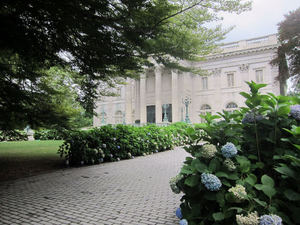Marble House, a national historic landmark situated among the mansions of Bellevue Avenue in Newport, Rhode Island, was built in 1892 for Mr. and Mrs. William Vanderbilt and was intended to serve as a modest summer cottage. The mansion is set back about 30 feet from the Bellevue Ave with an expansive, well-kept lawn and a beautiful marble façade. A large iron-wrought gate encloses the entirety of the mansion’s grounds, which include the lawn and a semicircular driveway which wraps around the front of the mansion and either side of the front lawn. The front entrance is enclosed by four white marble columns and surrounded by three windows on each side. The enormous mansion is silhouetted against a remarkable backdrop of the Atlantic Ocean where it meets a vast expanse of sky that pans out for miles behind the mansion. From this breathtaking point of view, one is able to get a tangible sense of the sheer enormity of the ocean.
In the 20th century, Marble House served as a summer vacation home for the Vanderbilt family, and it was a birthday present from William Vanderbilt to his wife, Alva Vanderbilt. Mr. Vanderbilt was the grandson of Commodore Cornelius Vanderbilt, who built the family’s fortune in the steamship industry as well as the New York Central Railroad. Clearly, they did not struggle financially. The mansion was designed by Richard Morris Hunt, who was inspired by the Petit Trianon in Versailles, France. Its construction included 500,000 cubic feet of marble as well as considerable amounts of gold, silver, and bronze. Marble House is estimated to be worth $11 million today.
The mansion was meant to stand in remembrance of the modest houses of the early 19th century. Many may think it is a complete mockery that the Vanderbilts referred to Marble House as a mere “modest summer home,” but in comparison to the lifestyle they were used to, modest may not be such an inaccurate description after all. Mr. Vanderbilt’s grandfather, Commodore Cornelius Vanderbilt, established a family fortune from the steamship and railroad industry, and his brother, Cornelius II, built the Breakers Mansion. So while Marble House was merely meant to serve as a cozy beach house, it soon became an architectural and historic landmark that transformed Newport’s reputation into that of a historic town overflowing with prosperity and magnificent stone palaces. 1
Upon visiting, the presentation of Marble House consists of a self-guided audio tour that allows the visitors to explore the most prominent rooms of the mansion, including the dining room, ballroom, bedrooms, sitting room, study, kitchen, hallways, and servants’ working quarters. While the presentation acknowledges that the servants had a very different lifestyle than their masters, it is not totally unbiased. It describes the Vanderbilts’ living quarters in extensive detail, while it only briefly touches on the lives of their servants. Visitors are only shown the kitchen and working quarters; they are not shown the servants’ sleeping or living quarters. This suggests an attempt to hide this aspect of the mansion from the general public, perhaps because it would encourage a negative response. The presentation also made sure to emphasize the positive aspects of servant life in the mansion, such as “having free reign of the mansion” while perhaps intentionally omitting the negative aspects. They intentionally portrayed the Vanderbilts’ treatments of their servants in a positive way. Overall, the presentation reflected a bias in favor of the Vanderbilts.
Interestingly enough, the presentation did not remain consistent in its partiality toward the Vanderbilts.The descriptions of the bedrooms, during the brief biographies of each member of the Vanderbilt family, reflected a liberal-minded, contemporary bias. Traditional marriage practices followed by the Vanderbilt family were reflected in a negative light. The presentation focused on Mr. and Mrs. Vanderbilt’s divorce and daughter Consuelo’s unhappy marriage, rather than mentioning William’s sisters’ successful arranged marriages. While many arranged marriages are unsuccessful, this is not always the case. However, the majority of modern-day Americans fiercely disapprove of arranged marriages, and this presentation demonstrates precisely that disapproval. As a result, the Marble House presentation was biased due to a contemporary, American liberal-minded mentality.
In my opinion, the most interesting aspect of Marble House is the contrast between the bedrooms of Alva Vanderbilt and everyone else. Alva significantly influenced the design of the mansion, and this is evident in the size and decorations of the bedrooms. Alva’s bedroom is considerably larger than the rest of the bedrooms and contains more elegant décor. While all of the bedrooms are quite lavishly adorned, Alva’s is definitely the most impressive. This is interesting, because it suggests that Alva had her own best interests at heart – personally, I found this rather amusing.
While my experience was generally a positive one, it could be improved if more of the servants’ quarters, particularly the sleeping quarters, were revealed to the public. The servants’ staircase should also be open to the public instead of being roped off. These changes would help to give a more open and unbiased presentation of the mansion. Otherwise, Marble House provides a pretty informative, descriptive account of the Vanderbilts’ life in the mansion.
_______________________________________________________________________________
1Preservation Society of Newport County, Marble House (2012).




